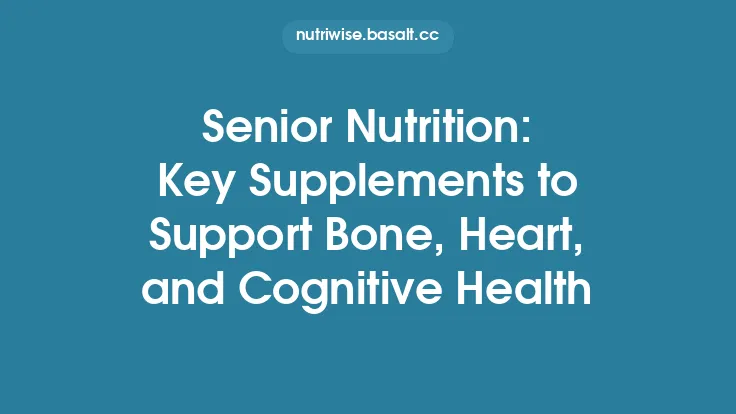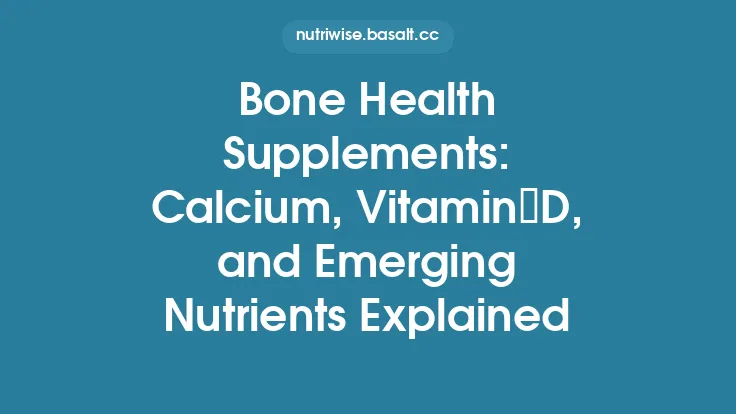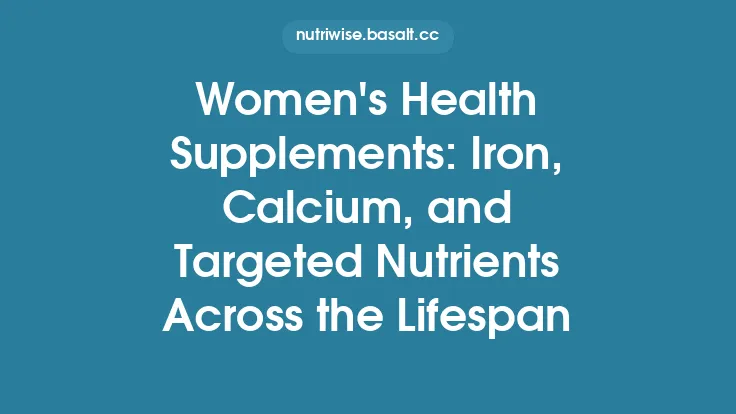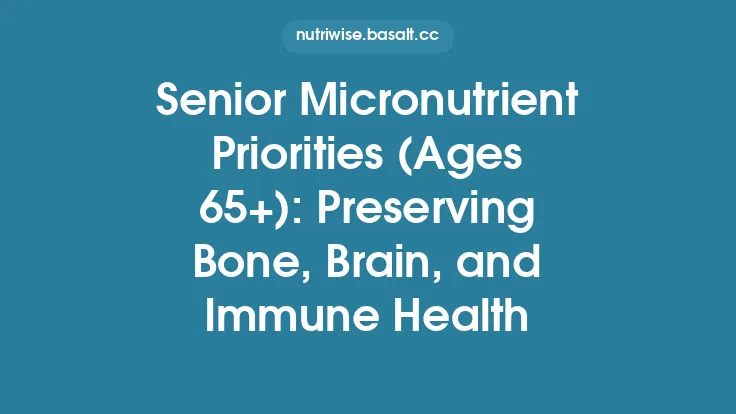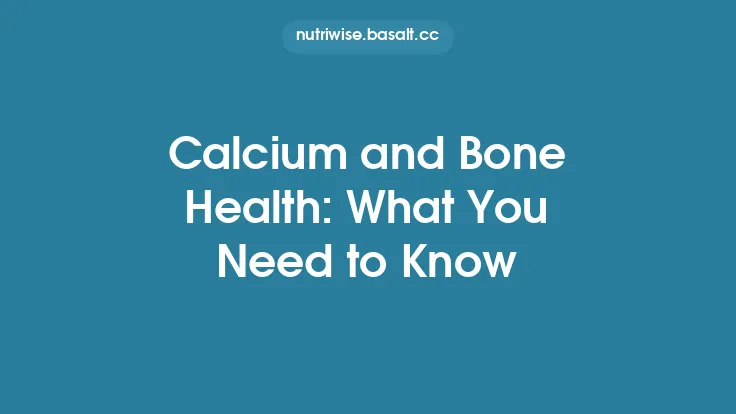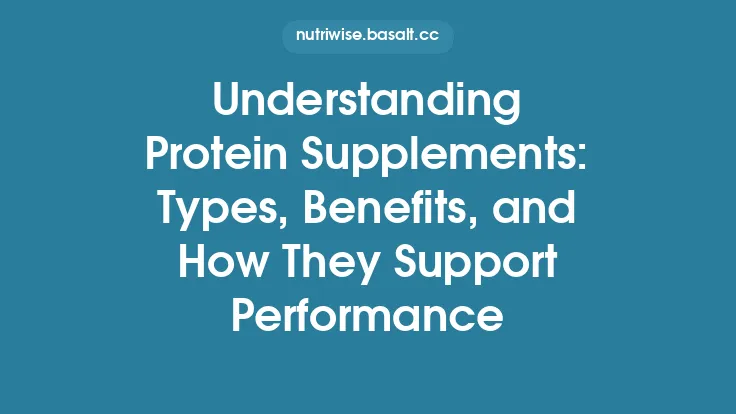Women’s health is uniquely influenced by the interplay of hormones, bone remodeling cycles, and daily energy demands. While a balanced diet, regular physical activity, and adequate sleep lay the foundation for optimal well‑being, many women find that targeted supplementation can help smooth hormonal fluctuations, preserve bone density, and sustain consistent energy levels throughout the month. This article delves into the science behind these three pillars—hormonal balance, bone strength, and energy support—offering evidence‑based supplement recommendations, dosage guidelines, and practical tips for integrating them safely into everyday life.
Understanding Hormonal Balance in Women
Hormones such as estrogen, progesterone, thyroid hormones, and cortisol orchestrate everything from menstrual regularity to mood, metabolism, and bone turnover. Even in the absence of pregnancy or menopause, women experience cyclical hormonal shifts that can manifest as premenstrual symptoms, occasional fatigue, or subtle changes in skin and hair health.
- Estrogen & Progesterone: These ovarian steroids rise and fall across the menstrual cycle, influencing fluid balance, neurotransmitter activity, and calcium metabolism. Fluctuations can lead to bloating, irritability, or cravings.
- Thyroid Hormones (T3/T4): Regulate basal metabolic rate and influence energy production. Subclinical hypothyroidism is more prevalent in women and can masquerade as low‑grade fatigue.
- Cortisol: The primary stress hormone, cortisol spikes in response to physical or emotional stressors. Chronic elevation can disrupt menstrual regularity and impair bone formation.
Maintaining a harmonious hormonal environment hinges on providing the body with the cofactors it needs to synthesize, metabolize, and clear these signaling molecules efficiently.
Key Nutrients for Supporting Hormonal Health
| Nutrient | Primary Role in Hormonal Regulation | Food Sources | Typical Supplemental Dose* |
|---|---|---|---|
| Vitamin B6 (Pyridoxine) | Co‑factor for progesterone synthesis; modulates neurotransmitters that affect mood | Chickpeas, bananas, salmon | 25–50 mg daily |
| Magnesium | Stabilizes estrogen receptors; supports cortisol regulation; essential for over 300 enzymatic reactions | Pumpkin seeds, leafy greens, dark chocolate | 200–400 mg elemental Mg (chelated forms like Mg‑glycinate) |
| Zinc | Crucial for aromatase activity (conversion of androgens to estrogen) and thyroid hormone metabolism | Oysters, beef, pumpkin seeds | 15–30 mg daily (as zinc picolinate) |
| Vitamin D3 | Modulates estrogen receptor expression; influences calcium absorption for bone health | Sunlight, fortified dairy, fatty fish | 1,000–2,000 IU daily (adjust based on serum 25‑OH‑D) |
| Omega‑3 Fatty Acids (EPA/DHA) | Anti‑inflammatory; help balance prostaglandin production, reducing menstrual discomfort | Fatty fish, algae oil | 1,000–2,000 mg combined EPA/DHA |
| Selenium | Supports conversion of thyroid hormones (T4 → T3) and antioxidant protection of ovarian tissue | Brazil nuts, tuna, sunflower seeds | 100–200 µg daily |
| Inositol (myo‑inositol & D‑chiro‑inositol) | Improves insulin sensitivity, which indirectly stabilizes ovarian hormone production; useful for PCOS‑related imbalances | Citrus fruits, beans, nuts | 2–4 g daily (split doses) |
| Adaptogenic Herbs (e.g., Ashwagandha, Rhodiola) | Modulate HPA‑axis activity, reducing cortisol spikes and supporting overall hormonal resilience | — | Ashwagandha 300–600 mg (standardized to 5 % withanolides) |
\*Doses reflect typical ranges used in clinical studies for healthy adult women; individual needs may vary based on diet, lifestyle, and lab results.
Why these nutrients matter:
- B‑vitamins act as enzymatic catalysts in steroidogenesis, ensuring that progesterone and estrogen are produced in appropriate ratios.
- Magnesium competes with calcium at the cellular level, preventing excessive uterine contractility that can exacerbate menstrual cramps.
- Zinc and selenium are integral to the function of enzymes that convert inactive hormone precursors into their active forms.
- Omega‑3s shift the balance of eicosanoids toward less inflammatory prostaglandins, often translating into milder premenstrual symptoms.
Bone Strength: Why Women Need Targeted Support
Even before the onset of menopause, women experience a net bone loss of approximately 1–2 % per year, largely driven by the cyclical dip in estrogen during the luteal phase. Estrogen is a potent inhibitor of osteoclast activity (cells that break down bone). When estrogen levels fall, bone resorption can outpace formation, especially in women with low dietary calcium or high caffeine intake.
Key risk modifiers include:
- Low body weight (less mechanical loading on bone)
- High caffeine or alcohol consumption (increases calcium excretion)
- Sedentary lifestyle (reduces osteogenic stimulus)
- Vitamin D insufficiency (impairs calcium absorption)
Addressing these factors with targeted nutrients can help preserve peak bone mass and reduce the long‑term risk of osteopenia.
Essential Minerals and Vitamins for Bone Health
| Nutrient | Function in Bone Metabolism | Food Sources | Recommended Supplemental Dose* |
|---|---|---|---|
| Calcium | Primary mineral of the bone matrix; required for mineralization | Dairy, fortified plant milks, leafy greens | 1,000 mg/day (split into 2–3 doses) |
| Vitamin D3 | Enhances intestinal calcium absorption; regulates osteoblast activity | Sunlight, fatty fish, fortified foods | 1,000–2,000 IU/day (adjust to serum 25‑OH‑D >30 ng/mL) |
| Vitamin K2 (MK‑7) | Directs calcium to bone and teeth, away from arteries; activates osteocalcin | Natto, hard cheeses, fermented foods | 90–120 µg/day |
| Magnesium | Constitutes ~60 % of bone mineral; co‑factor for vitamin D activation | Nuts, seeds, whole grains | 300–400 mg elemental Mg |
| Boron | Modulates calcium and magnesium metabolism; supports estrogen activity | Avocados, raisins, almonds | 1–3 mg/day |
| Strontium (as strontium citrate) | May increase bone formation and reduce resorption (use with caution) | — | 300–600 mg/day (consult healthcare provider) |
| Collagen Peptides (Hydrolyzed Type I) | Provides amino acids (glycine, proline) for the organic bone matrix | — | 5–10 g/day (mixed in beverages) |
\*These doses are typical for adult women with normal renal function and no contraindicating conditions. Individuals with kidney disease or hypercalcemia should seek professional guidance.
Practical integration tips:
- Calcium is best absorbed in 200–300 mg increments; a single 1,000 mg tablet may be less effective than multiple smaller doses spread throughout the day.
- Vitamin D works synergistically with K2; taking them together can improve calcium utilization and reduce the theoretical risk of vascular calcification.
- Magnesium taken in the evening can also aid sleep quality, indirectly supporting bone health by reducing cortisol‑driven bone resorption.
Energy Metabolism: The Role of Supplements
Energy fatigue in women often stems from a combination of hormonal fluctuations, suboptimal nutrient status, and lifestyle stressors. While caffeine provides a short‑term boost, it can exacerbate cortisol spikes and interfere with sleep, creating a vicious cycle. Targeted supplementation can instead support mitochondrial efficiency, stabilize blood glucose, and improve oxygen delivery without the crash.
Key metabolic pathways to consider:
- Aerobic respiration (oxidative phosphorylation) – relies on B‑vitamins, iron, and coenzyme Q10.
- Anaerobic glycolysis – depends on adequate magnesium and riboflavin.
- Fat oxidation – enhanced by carnitine and omega‑3 fatty acids.
Adaptogens and Mitochondrial Boosters for Sustained Vitality
| Supplement | Mechanism of Action | Typical Dose | Timing |
|---|---|---|---|
| Coenzyme Q10 (Ubiquinol) | Electron carrier in the mitochondrial respiratory chain; antioxidant | 100–200 mg daily | With meals containing fat |
| L‑Carnitine (Acetyl‑L‑carnitine) | Transports long‑chain fatty acids into mitochondria for β‑oxidation; supports neurotransmitter synthesis | 500–1,000 mg daily | Morning |
| Riboflavin (Vitamin B2) | Precursor for FAD/FMN, essential for oxidative metabolism | 1.4 mg RDA (often 10–20 mg in supplement) | With meals |
| Ashwagandha (Withania somnifera) | Modulates HPA‑axis, reduces cortisol, improves ATP production | 300–600 mg standardized extract | Morning or early afternoon |
| Rhodiola rosea | Increases cellular NAD⁺ levels, enhances oxygen utilization | 200–400 mg standardized (3 % rosavins, 1 % salidroside) | Early morning, avoid late afternoon |
| Iron (as ferrous bisglycinate) | Essential for hemoglobin and cytochrome enzymes in mitochondria; deficiency leads to fatigue | 8–18 mg elemental iron (if labs indicate low ferritin) | With vitamin C, separate from calcium |
| Vitamin C | Improves iron absorption; antioxidant protecting mitochondrial membranes | 500–1,000 mg daily | With iron-containing meals |
Evidence snapshot:
- A 12‑week randomized trial in premenopausal women showed that 600 mg/day of ashwagandha reduced perceived stress scores by 30 % and improved VO₂ max by 5 % compared with placebo.
- CoQ10 supplementation (200 mg/day) for 8 weeks increased cellular ATP levels by ~15 % in a cohort of healthy women reporting chronic low‑grade fatigue.
Integrating Supplements into a Holistic Lifestyle
- Start with a Baseline Assessment
- Conduct a basic blood panel (25‑OH‑D, ferritin, B12, magnesium, zinc, thyroid panel) to identify deficiencies.
- Track menstrual symptoms, energy patterns, and bone health markers (e.g., occasional heel‑ultrasound if available).
- Prioritize Food First
- Aim for a Mediterranean‑style diet rich in oily fish, nuts, seeds, legumes, and colorful vegetables. This naturally supplies many of the nutrients discussed.
- Use supplements to fill gaps rather than replace whole foods.
- Stagger Supplement Timing
- Morning: B‑vitamins, CoQ10, L‑carnitine, adaptogens (ashwagandha, rhodiola).
- Midday: Vitamin D + K2, omega‑3s (with a meal containing fat).
- Evening: Magnesium, calcium (if not taken earlier), collagen peptides.
- Mindful Pairings
- Vitamin C enhances iron absorption; take together.
- Calcium can inhibit iron and zinc absorption; separate by at least 2 hours.
- Fat‑soluble vitamins (D, K2) require dietary fat for optimal uptake.
- Lifestyle Synergy
- Weight‑bearing exercise (e.g., brisk walking, resistance training) 3–4 times weekly amplifies the bone‑protective effects of calcium, vitamin D, and magnesium.
- Stress‑reduction practices (mindfulness, yoga) complement adaptogenic herbs by lowering cortisol.
- Adequate sleep (7–9 hours) supports hormonal regulation and mitochondrial repair.
Safety, Quality, and Choosing the Right Products
- Third‑Party Testing: Look for certifications such as NSF Certified for Sport, USP Verified, or ConsumerLab approval to ensure label accuracy and absence of contaminants.
- Form Matters:
- Magnesium glycinate or malate are better absorbed and gentler on the gut than magnesium oxide.
- Zinc picolinate offers higher bioavailability than zinc gluconate.
- Ubiquinol (the reduced form of CoQ10) is more readily utilized than ubiquinone, especially in individuals over 30.
- Potential Interactions:
- High-dose calcium can interfere with iron and zinc absorption.
- Thyroid medication (levothyroxine) should be taken on an empty stomach, separate from calcium, iron, and high-fiber supplements.
- Anticoagulant users should monitor vitamin K intake; however, K2 (MK‑7) at typical supplemental doses is generally safe but warrants physician discussion.
- Pregnancy & Lactation Exclusion: This guide is intended for non‑pregnant, non‑lactating women. Those in those life stages should consult a healthcare professional before initiating any new supplement regimen.
Frequently Asked Questions
Q: How long does it take to notice improvements in hormonal symptoms?
A: Many women report reduced premenstrual discomfort within 4–6 weeks of consistent B‑vitamin, magnesium, and omega‑3 supplementation. Hormonal modulation is gradual; patience and adherence are key.
Q: Can I take all these supplements together?
A: While most are compatible, spacing calcium, iron, and zinc by a couple of hours maximizes absorption. A structured schedule (morning vs. evening) helps avoid competition.
Q: Do I need a bone density scan if I’m under 40?
A: Routine DXA scans are generally reserved for post‑menopausal women or those with risk factors (family history of osteoporosis, chronic steroid use). However, a baseline assessment can be useful if you have a low body weight, a history of fractures, or menstrual irregularities.
Q: Are plant‑based omega‑3s as effective as fish oil?
A: Algal oil provides EPA and DHA directly, bypassing the conversion step required for ALA (found in flaxseed). It is a suitable vegan alternative with comparable bioavailability.
Q: What if I have a mild thyroid issue?
A: Ensure adequate selenium and iodine (150 µg/day) while monitoring thyroid function tests. Avoid excessive soy isoflavones, which can interfere with thyroid hormone synthesis in susceptible individuals.
By aligning supplement choices with the physiological demands of hormonal regulation, bone remodeling, and energy metabolism, women can proactively support their health across the reproductive years. Remember that supplements are most effective when paired with a nutrient‑dense diet, regular physical activity, and stress‑management practices. When in doubt, consult a qualified healthcare professional to tailor the regimen to your unique biochemistry and lifestyle.
